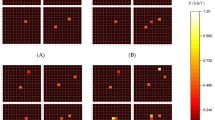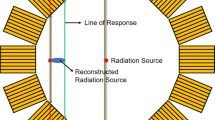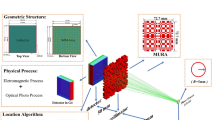Abstract
In a positron emission tomography detector, the process required to measure the position of a specific scintillation pixel where gamma rays interact with a pixel is somewhat complex. It is necessary to acquire flood images, segment them, and classify and organize them by region. When a new incident gamma ray is assigned to a corresponding area through position reconstruction of a signal generated, it is considered to have interacted with a specific scintillation pixel. In this work, a study was conducted using deep learning to simplify the position measurement of scintillation pixels that interact with gamma rays through various steps. A deep learning model was trained using the ratio of the signal for each position of the scintillation pixel obtained through simulation. The experimental data were converted into a signal ratio and used as an input value, and the position of the scintillation pixel was directly measured as a digital signal. After segmentation of the flood image, the data for each region of each scintillation pixel were applied to the deep learning-based position measurement method to evaluate the accuracy of the position measured by deep learning. The proposed method achieved an average accuracy of 96.98%, and the position of the error was mainly at the point where the areas were split. The convenience of image reconstruction can be improved in existing detectors by this method of specifying the position of the scintillation pixel through deep learning.







Similar content being viewed by others
Change history
26 July 2023
An Erratum to this paper has been published: https://doi.org/10.1007/s40042-023-00889-5
References
Y. LeCun, Y. Bengjo, G. Hinton, Nature 521, 436 (2015)
D. Shen, G. Wu, H.-I. Suk, Annu. Rev. Biomed. Eng. 19, 221 (2017)
A. Esteva, K. Chou, S. Yeung, N. Naik, A. Madani, A. Mottaghi, Y. Liu, E. Topol, J. Dean & R. Socher, NPJ Digital Medicine, 4, article number 5 (2021).
D. Ravi, C. Wong, F. Deligianni, M. Berthelot, J. Andreu-Perez, B. Lo, G.-Z. Yang, IEEE J. Biomed. Health Inform. 21, 4 (2016)
I. Castiglioni, L. Rundo, M. Codari, G.D. Leo, C. Salvatore, M. Interlenghi, F. Gallivanone, A. Cozzi, N.C. D’Amico, F. Sardanelli, Physica Med. 83, 9 (2021)
T. Wang, Y. Lei, Y. Fu, J.F. Wynne, W.J. Curran, T. Liu, X. Yang, J. Appl. Clin. Med. Phys. 22, 11 (2021)
M.H. Hesamian, W. Jia, X. He, P. Kennedy, J. Digit. Imaging 32, 582 (2019)
M.U. Ghani, W.C. Karl, IEEE Trans. Comput. Imaging 6, 181 (2019)
M.F. Spadea, M. Maspero, P. Zaffino, J. Seco, Med. Phys. 48, 6537 (2021)
J. Solomon, P. Lyu, D. Marin, E. Samei, Med. Phys. 47, 3961 (2020)
H. Arabi, A. AkhavanAllaf, A. Sanaat, I. Shiri, H. Zaidi, Physica Med. 83, 122 (2021)
B. Jo, S.-J. Lee, J. Korean Soc. Radiol. 16, 797 (2022)
M. Makek, D. Bosnar, A.M. Kozuljevic, L. Pavelic, Crystals 10, 1073 (2020)
S.J. Kang, J.M. Park, J.Y. Lee, H.L. Kim, J.K. Son, New Phys. Sae Mulli 65, 474 (2015)
J. Du, J.P. Schmall, Y. Yang, K. Di, E. Roncali, G.S. Mitchell, S. Buckley, C. Jackson, S.R. Cherry, Med. Phys. 42, 585 (2015)
C.M. Pepin, R. Lecomte, Nucl. Inst. Methods Phys. Res. A 488, 670 (2002)
G. Romanchek, Y. Wang, H. Marupudi, S. Abbaszadeh, Sensors 20, 6092 (2020)
Acknowledgements
This research was supported by Basic Science Research Program through the National Research Foundation of Korea (NRF) funded by the Ministry of Education (No. 2022R1I1A3064473).
Author information
Authors and Affiliations
Corresponding author
Additional information
Publisher's Note
Springer Nature remains neutral with regard to jurisdictional claims in published maps and institutional affiliations.
Rights and permissions
Springer Nature or its licensor (e.g. a society or other partner) holds exclusive rights to this article under a publishing agreement with the author(s) or other rightsholder(s); author self-archiving of the accepted manuscript version of this article is solely governed by the terms of such publishing agreement and applicable law.
About this article
Cite this article
Jo, B., Lee, SJ. Preliminary study on PET detector digital positioning of scintillation pixels using deep learning. J. Korean Phys. Soc. 83, 403–408 (2023). https://doi.org/10.1007/s40042-023-00856-0
Received:
Revised:
Accepted:
Published:
Issue Date:
DOI: https://doi.org/10.1007/s40042-023-00856-0




